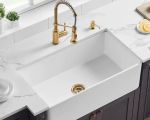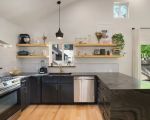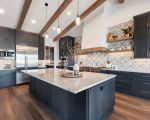Transform Your Kitchen with an Industrial Style
Remodeling a kitchen is one of the most exciting and rewarding home improvement projects you can undertake. The kitchen is often the heart of the home, and with the rise of industrial-style design, many homeowners are opting to embrace this edgy yet functional style for their renovations. But what exactly is industrial style, and how can you apply it to your kitchen? Let me walk you through the process of remodeling a kitchen with an industrial style, sharing tips, challenges, and my personal experience along the way.
Understanding Industrial Style in Kitchen Design
Industrial style is all about raw, unfinished elements that bring a rustic, modern look to your home. Imagine exposed brick walls, steel beams, concrete countertops, and vintage light fixtures. It’s a style that combines modern sleekness with a touch of rugged charm. This style first emerged in the early 20th century as factories and warehouses were converted into loft apartments in major cities. Today, it has become one of the most sought-after kitchen aesthetics, especially in urban areas.
The beauty of industrial design is in its simplicity and focus on materials. The raw, unfinished look is not about perfection but about embracing the natural imperfections that come with materials like wood, metal, and concrete. So, how do you bring this style into your kitchen? Let me share my personal experience and what worked for me.
Step 1: Planning Your Industrial Kitchen Layout
Before diving into the design process, the first step is to plan out your kitchen layout. The key to a successful industrial kitchen remodel is functionality. Start by considering your needs: Do you entertain guests often? Do you cook daily or more casually? These questions will help you determine the best layout for your space. For example, I knew I wanted a spacious, open kitchen with a lot of counter space. I also needed to make sure there was ample storage, which is a common challenge in industrial kitchen designs. Many industrial kitchens feature open shelving, which looks stylish but can sometimes lead to clutter. I opted for a combination of closed cabinets with a few open shelves to balance aesthetics and practicality.
Step 2: Choosing the Right Materials
When it comes to industrial kitchens, the choice of materials is crucial. Steel, concrete, brick, and reclaimed wood are the hallmark materials of this style. For my kitchen, I decided to use exposed brick for one of the walls. This gives the space an authentic, urban feel. However, I wanted to make sure that the brick didn’t overwhelm the room, so I opted for a soft red tone rather than a dark, harsh brick. For countertops, I went with concrete – sleek, durable, and quintessentially industrial. The concrete counter not only looks stunning but also fits perfectly with the other materials. To soften the starkness of the concrete, I incorporated some warm wood accents through floating shelves and a wooden bar area. The contrast between the cold steel and warm wood gives the space balance and visual interest.
Step 3: Incorporating Industrial Lighting
Lighting is one of the easiest ways to capture the industrial aesthetic. Think exposed bulb light fixtures, pendant lights, and track lighting. The goal is to create a space that feels well-lit and open, but with a rustic edge. For my kitchen remodel, I chose oversized, industrial-style pendant lights to hang above the kitchen island. These lights not only look amazing but provide ample lighting for food preparation and gatherings. I also added a few exposed filament bulbs in vintage-style sockets for a more authentic industrial touch.
Step 4: Adding Personal Touches
While industrial style is known for its rugged simplicity, there’s no reason your kitchen can’t feel warm and inviting. In my case, I added a few personal touches that gave the space some personality without compromising the industrial theme. I hung up vintage art prints with a bit of a retro vibe, and I also brought in a few plants to add a touch of greenery. Plants like succulents or ferns work particularly well in industrial kitchens because they provide color and life against the otherwise neutral color palette of concrete and metal.
Step 5: Organizing and Maximizing Storage
Storage can be a challenge in industrial kitchens, especially if you love the open shelving look but want to avoid clutter. I recommend using a combination of open and closed storage. For example, I used open shelving to display some of my favorite kitchenware, while keeping less attractive items behind closed doors. Additionally, I incorporated a large industrial-style island with built-in drawers for utensils and kitchen tools. This helped keep the kitchen looking tidy and functional.
Step 6: Final Touches to Complete the Look
Once the big pieces are in place, it’s time for the final touches. Industrial-style kitchens often feature minimalist décor, so don’t feel the need to overcrowd the space with unnecessary items. I added a few metal bar stools to the island, a couple of retro-style coffee mugs, and some sleek black cookware to tie the whole space together. Remember, it’s about the details – the right accessories can really elevate the industrial feel of your kitchen.
Throughout the remodel, I encountered a few challenges, like sourcing the right materials and ensuring that the layout was both functional and stylish. However, with some careful planning and a little creativity, I managed to create a kitchen that’s both practical and beautifully industrial. If you’re considering remodeling your kitchen in this style, I hope these tips inspire you to start your own project and bring a touch of modern industrial charm to your home.








